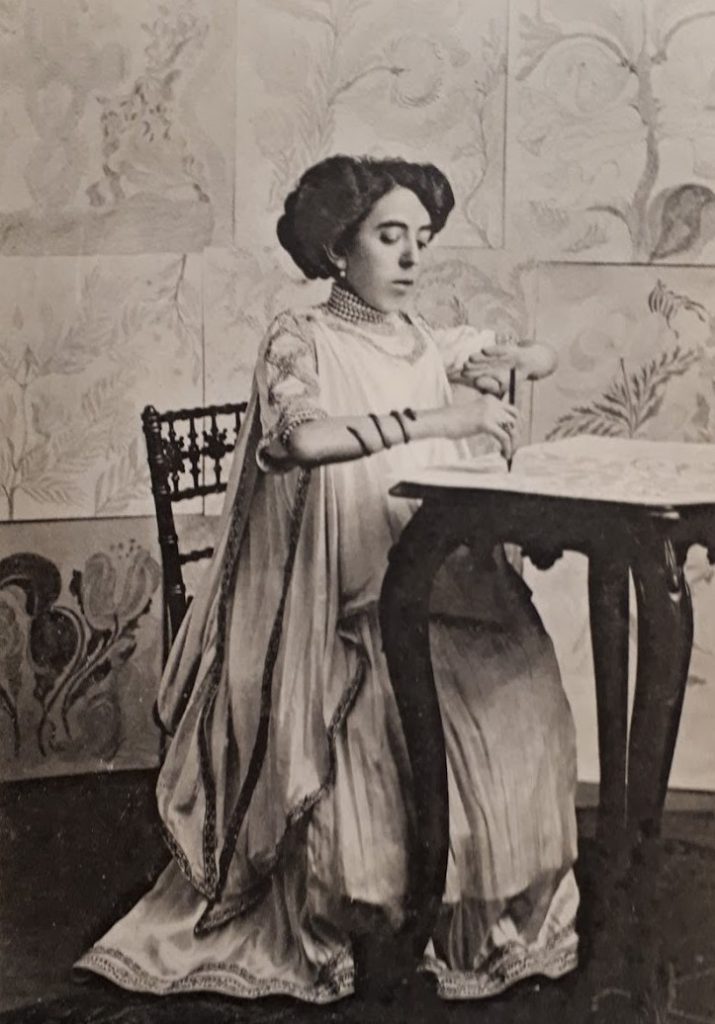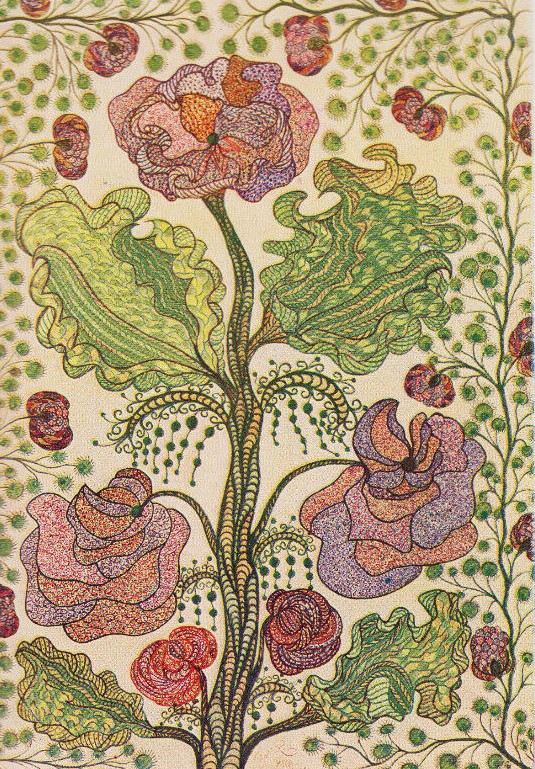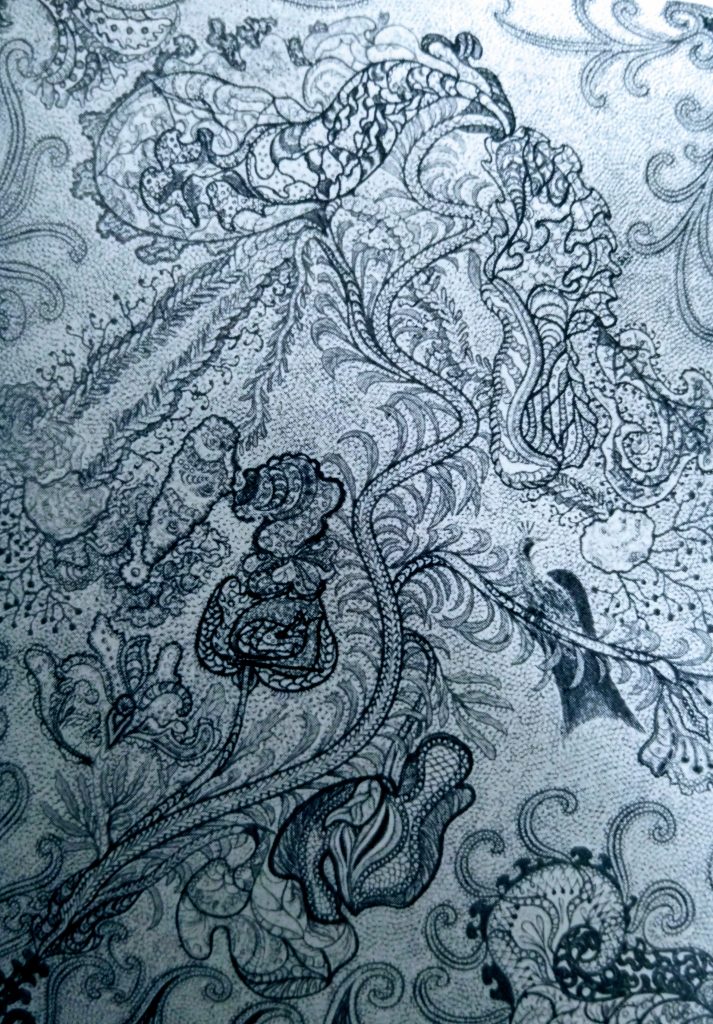
Frieda Gentes’ spirit drawings were the focus of an article called The Phenomena of Frieda Gentes by Emil Mattiesen published in April 1914 in the Journal of the Society for Psychical Research. It gave a comprehensive account of German Gentes’ art who had discovered in 1910 that she could draw mediumistically without any prior art education. Her work which often bore the signature ‘Conrad v Ramsavi only exists today in printed form created from postcards on the occasions of her numerous exhibitions and press coverage.
The following text is a summary of Mattiesen’s report which began by stating that “Gentes’ drawing trances have been closely investigated by medical authorities and found to be genuine. The cases of supernormal knowledge, referred to in this report, were not connected with any professional interest. It may be added that all observers concur in attesting her personal integrity and truthfulness, and I may say that my own observations lead me very sincerely to endorse this opinion”.
“Miss Frieda Gentes was born in 1880. Her parents, she says, were healthy people; at least, without nervous complaints of any sort. The medium herself, however, appears to be of a very delicate constitution, pale and transparent, not reaching above 4 feet, her back curved and her finger-joints swollen. Her heart also causes her trouble. Her automatic drawing started abruptly one evening towards the end of January, 1910, when she was bedridden with rheumatism. During the preceding night Miss Gentes had twice, on awaking, found her hands bathed in perspiration. The next evening, while she was noting down the press-marks of some books her sister was to fetch for her from the Public Library, the pencil suddenly drew a horizontal line across the paper and below that a flowery design of the type developed later on in her more elaborate pictures. She had been reading and was wide awake during the whole process, which was repeated next night, rather late. This time she used a blue pencil, and a flower was drawn upside-down. She was still wide-awake, and able to converse during the drawing. Then very soon she began to fall into trance during the drawing process.”

Several years later, a medical report by Dr. A. Meier of Munich was written on March 18, 1913 after Gentes gave a special demonstration of her drawing to a private circle of members of the Society for Scientific Psychology in Munich, at which some medical men and an experienced practical hypnotist were present. Miss Gentes, by concentration of thought and by a peculiar modification of her breathing, auto-hypnotically induces a state of unconsciousness within 3 minutes. The colour of the face in this condition of total unconsciousness and anaesthesia is pale, the eyelids are nearly closed, leaving only a narrow chink, the eyes slightly converge, the pupils are of mean size, and not reacting upon light, unless rather strong. When the state of unconsciousness began, the left arm was slowly bent at the elbow-joint into a right angle, raised up to the level of the eyes, the fingers of this hand being abnormally extended, and arm and head remained in this cataleptic state without any change during the whole performance, which lasted nearly an hour and three-quarters. The right hand chooses, evidently without being controlled by the eye, out of a great number of coloured pencils lying on one side, those which fit the drawing, and with them traces the drawing with moderate speed on a sheet lying in front of the lady. In this work the eye undoubtedly exercises some control, for as soon as the eyes are covered by a piece of paper held in front of them, a noticeable unsteadiness sets in and the contours of the drawing are no longer adhered to with the previous exactness. In this state Miss Gentes, when called or spoken to, does not react at all, or, at times, very feebly. ” If the drawing material is removed, the left arm soon sinks back into the lap, breathing becomes deeper, often resembling convulsive sobbing, the mimic muscles twitch and are distorted as in suppressed weeping, and after one more vehement twitch, along with a little shriek, Miss Gentes again awakes. During the process of awakening Miss Gentes is somewhat at sea, like a sleeper suddenly awakened; the perfect mental clearness again is established. Miss Gentes denies any fatigue even in the left arm, held up for so long. After waking there is total amnesia.

Matthiesen also had an opportunity to watch Gentes’ trance first hand in Berlin where the artist lived on June 4, 1913, and agreed with the medical statement adding: “There were some sixty pencils on the table, well mixed up, on the right side of the medium. Miss Gentes certainly does not choose those she wants to employ by her eyesight. I also made the experiment of the ” screen,” which left no doubt of the eyes being used in some dreamy fashion. Miss Gentes told me that for some ten minutes after the conclusion of the trance, her eyesight was greatly impaired. The trance at times comes on spontaneously, when not expected, but she is able to resist it if she wanted to. It is preceded by a certain feeling of restlessness and oppression, which seems to radiate from the heart or the solar plexus, as Miss Gentes puts it. She feels sick, the twitching sets in (she has no special sensations in the arm), and she quickly loses consciousness. Her visual power, I am inclined to think, is rather enhanced during the trance. Some of her drawings take twenty five or even fifty hours to finish, while her trance has never exceeded eight hours.
A mental (subconscious) origin of the catalepsy of the left arm is suggested by the fact that it has been interrupted repeatedly by the will of the trance personality. On such occasions it has declared that the catalepsy is intended to prove the genuineness of the trance, and has challenged bystanders to imitate the feat, which they, of course, have been unable to do, exhaustion of the limb very soon forcing them to drop it, while the medium was holding up her arm for hours at a stretch without any fatigue being noticeable. As to the intrinsic ” value” of the drawings, everybody has, of course, to judge for himself. The effect of the originals is largely due to their gorgeous and not disharmonious colouring. Very tiny circles, put closely together in great numbers, like pearls in old-fashioned needlework, make up a great part of the designs, and form the ground in some of them, while in others great areas of even colouring, smoothed to a perfect polish, are introduced.”
According to Matthiesen’s report, Gentes often received messages during the drawing process via automatic writing, or through her clairvoyant and clairaudient abilities. It also investigates her ability to have foreseen the death of her sister, Elsa Gentes, in a Berlin railway accident in 1908. Like many other mediumistic artists this death may have been the catalyst for Gentes to develop an interest in spiritualism and mediumistic drawing. Although, according to Hans Freimark, author of a book on Mediumistic Art published in 1914, he suggested that Gentes’ automatism could have been instigated by her knowledge of the work of another German drawing medium – Wilhelmine Assmann who had achieved a great deal of notoriety in the press. Sadly, whereas a few works by Assmann have survived, albeit suffering the ravages of time, original artworks by Gentes are difficult, if not impossible, to find today.
For more mediumistic artists like Gentes who worked with botanical themes see our other websites Madge Gill and Georgiana Houghton